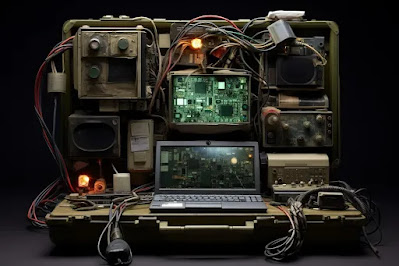Revolutionary Computer Peripheral Devices
In the dynamic world of technology, computer peripheral devices play a crucial role in enhancing connectivity, productivity, and user experience. These devices, ranging from input to output, storage to communication, have revolutionized the way we interact with computers. From traditional keyboards to sophisticated webcams, the landscape of computer peripherals has witnessed remarkable advancements. In this article, we delve into the realm of revolutionary computer peripheral devices, exploring their evolution, types, impact, and future trends.
Evolution of Computer Peripheral Devices
The journey of computer peripheral devices dates back to the early days of computing when punch cards were used for data input. With technological advancements, the landscape evolved, giving rise to devices like keyboards, mice, and monitors. The transition from wired to wireless connectivity further revolutionized the concept of peripherals, making them more versatile and convenient.
Types of Revolutionary Computer Peripheral Devices
Input Devices
Keyboards
Keyboards serve as the primary input interface for computers, enabling users to type text, commands, and shortcuts. The evolution of keyboards has seen the integration of ergonomic designs, backlighting, and customizable keys, catering to diverse user preferences.
Mice and Trackpads
Mice and trackpads provide intuitive cursor control, facilitating precise navigation and interaction with graphical user interfaces. Advanced features such as touch sensitivity, gesture recognition, and wireless connectivity have enhanced user experience and productivity.
Touchscreens
Touchscreens have redefined user interaction, enabling direct manipulation of on-screen elements through touch gestures. From smartphones to interactive displays, touch technology has become ubiquitous, offering seamless navigation and engagement.
Output Devices
Monitors
Monitors display visual output from computers, ranging from text and graphics to videos and games. The evolution of monitors has led to improvements in resolution, refresh rate, and color accuracy, catering to professional and gaming applications.
Printers
Printers translate digital content into physical documents, photographs, and artworks. With advancements in printing technology, modern printers offer high-resolution output, wireless connectivity, and multifunctional capabilities, catering to diverse printing needs.
Projectors
Projectors display large-scale visual content onto screens or surfaces, making them ideal for presentations, entertainment, and educational purposes. The integration of compact designs, high brightness, and wireless connectivity has expanded the versatility of projectors.
Storage Devices
External Hard Drives
External hard drives provide additional storage capacity for storing backups, multimedia content, and large files. The evolution of external hard drives has led to improvements in speed, reliability, and portability, facilitating data management and transfer.
USB Flash Drives
USB flash drives offer portable storage solutions for transferring files between devices. With increasing storage capacities and compact designs, USB flash drives have become indispensable tools for data storage and transportation.
Solid State Drives (SSDs)
Solid state drives utilize flash memory technology for storing and accessing data, offering faster read/write speeds and enhanced durability compared to traditional hard drives. The adoption of SSDs has led to significant improvements in system performance and responsiveness.
Communication Devices
Modems
Modems facilitate internet connectivity by modulating and demodulating digital data signals over telephone lines or cable networks. The evolution of modems has transitioned from dial-up to broadband technologies, enabling faster and more reliable internet access.
Network Interface Cards (NICs)
Network interface cards enable computers to connect to local area networks (LANs) or wireless networks. The integration of gigabit Ethernet, Wi-Fi, and Bluetooth connectivity has facilitated seamless network communication and collaboration.
Wireless Adapters
Wireless adapters enable wireless connectivity for devices that lack built-in wireless capabilities. From Wi-Fi dongles to Bluetooth adapters, wireless connectivity has become pervasive, enabling mobility and flexibility in network access.
Multimedia Devices
Webcams
Webcams capture video and audio content, facilitating video conferencing, live streaming, and content creation. The evolution of webcams has led to improvements in resolution, low-light performance, and integration with facial recognition technology.
Headsets and Microphones
Headsets and microphones provide audio input and output for communication, gaming, and multimedia applications. With features such as noise cancellation, surround sound, and wireless connectivity, headsets offer immersive audio experiences.
Speakers
Speakers reproduce audio output from computers, enhancing the multimedia experience for users. The integration of advanced drivers, amplifiers, and audio processing technologies has resulted in high-fidelity sound reproduction and immersive listening experiences.
Impact of Revolutionary Computer Peripheral Devices on Work and Lifestyle
Revolutionary computer peripheral devices have had a profound impact on work productivity, entertainment, communication, and lifestyle. By enhancing connectivity, functionality, and user experience, these devices have transformed the way we interact with technology, empowering individuals and organizations to achieve more.
Future Trends in Computer Peripheral Devices
The future of computer peripheral devices holds exciting possibilities, driven by advancements in connectivity, artificial intelligence, and user interface technologies. From augmented reality peripherals to brain-computer interfaces, the next wave of innovations promises to redefine human-computer interaction and elevate the digital experience.
Conclusion
In conclusion, revolutionary computer peripheral devices have played a pivotal role in shaping the digital landscape, offering enhanced connectivity, functionality, and user experience. From input to output, storage to communication, these devices continue to evolve, driving innovation and transforming the way we interact with technology. As we embrace the future of computing, the possibilities are limitless, ushering in a new era of connectivity, creativity, and productivity.
Unique FAQs
What are some emerging trends in computer peripheral devices?
- Emerging trends include augmented reality peripherals, haptic feedback devices, and voice-controlled interfaces.
How do computer peripheral devices impact productivity in the workplace?
- Computer peripheral devices enhance productivity by providing intuitive input/output interfaces, facilitating seamless communication, and enabling efficient data storage and access.
Are there any environmental considerations associated with computer peripheral devices?
- Yes, environmental considerations include energy efficiency, recyclability, and eco-friendly materials in manufacturing.
What role do computer peripheral devices play in gaming and entertainment?
Computer peripheral devices enhance gaming and entertainment experiences by providing immersive audiovisual feedback, precise control inputs, and seamless connectivity for multiplayer gaming and streaming.
Read Also:

.jfif)
.jfif)

Comments
Post a Comment